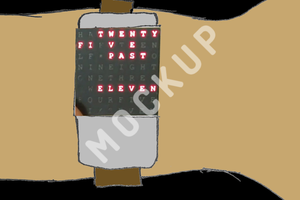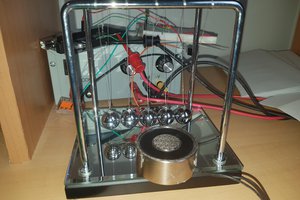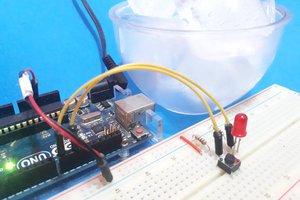Enclose them all in super clear epoxy!
Very recently I was so impressed by a Japanese modern artist who draws golden fish in epoxy. I cannot draw but make circuit. Why not!
Very recently I was so impressed by a Japanese modern artist who draws golden fish in epoxy. I cannot draw but make circuit. Why not!
To make the experience fit your profile, pick a username and tell us what interests you.
We found and based on your interests.
This time, I made more simple object just for joy. the above picture shows the object buried inside epoxy resin. Indeed they are object for N-gauge model train, and I added several tiny (1005 (0403)) size LEDs for headlight of car, traffic signals. Just turning on is not so interesting, so I put Arduino boot loader loaded ATmega328 below the basement of traffic signal. I made it looks like the car is ready to fly!!
And here is the completed one. Signal is controlled by MCU and actual operation can be found in the following movie... Have fun!
Here I made a short demo movie. All of firmware is uploaded through OTA (over the air), The case of nRF, firmware uploading is quite safe because boot loader and application are separated in memory, but the case of ESP32, the OTA code and user code are mixed up in the program and it's very, very easy to make it BRICK (lose control, turns into static object..)
Here is the way to make it brick in ESP32 OTA
void loop() {
ArduinoOTA.handle();
pinMode(LED, HIGH);
delay(1000);
pinMode(LED, LOW);
delay(1000);
}
The function, "ArduinoOTA.handle()" must be kept in running in loop function but blinking LED (especially delay() function) will interrupt its operation. Once this code is uploaded through OTA, it will "brick" the module and we need wired firmware uploading (but in the epoxy, no way.)
The correct way is, (not the only way, just example)
void loop() {
ArduinoOTA.handle();
long int hoge=millis();
if(hoge%1000==0){
digitalWrite(LED,HIGH);
}
if(hoge%1500==0){
digitalWrite(LED,LOW);
}
Taking a time from mills() and delay() should never be used in loop function. This case ArduinoOTA.handle() keeps running and sometimes LED will switch HIGH and LOW.
You may just think these are real fish, but in fact they are drawing. A few weeks ago, I got to know it on TV program, and very the same day I went to a museum currently presenting this art.
This encounter was almost "groundbreaking" to me, but unfortunately I am not good at drawing but I want something inspired by this wonderful shock.
Actually I did not know the existence of this material "super clear epoxy". As you see, it is really clear and looks like floating inside transparent object. Currently it is just the beginning but I will try make more by using this wonderful material. On the next project log, I will explain how to program them (as you guess, it's OTA)..
It's a "Crystal Resin Neo" made by Nissin Resin in Japan. The point of this resin is, "super tolerance for turning yellow". It seems, general epoxy resin turns into yellow after a certain period time but this resin has a tolerance for it (keeping it crystal clear). Similar items (I am not sure their quality but) also can be found in Amazon and we can try as we wish!
Create an account to leave a comment. Already have an account? Log In.
Hi
Nice to meet you after viewing your profile i am Jacinda, from (jakarta) indonesia,
i have a project discussion with you please email me on: (jacinda.seiler@yahoo.com)
It would be interesting to see a crystal radio encased in clear resin. Tuning capacitors would be hard to safely encase, but there's another option...
Ever heard of the "rocket" crystal radio? It moves a ferrite rod in the coil, to vary inductance.
Careful drilling of an encased radio could let you add the tuning ferrite as a final step.
I'd make a solar powered "Magic 8-ball" using tech like this. I personally have too long of a queue of things to do to do it myself, but others might have the time. The use of a super-capacitor for energy storage would likely be enough. Making a polyhedron of dark solar cells would make it dark like an 8-ball. It would just sit there charging in the ambient light and when disturbed, it could turn on and generate a message until the power runs out and then shut off. One should also be able to distribute the weight so the ball always rolls onto it's inverted face down position no matter how it is set down. I'd love to see that. :-) 🦊
Just wanted to leave a little note saying how much I enjoyed your take on the goldfish artist! And not trying to be contrary, but felt I had to question the veracity of 1 key point that you tried to emphasize at the beginning of your article : "Unfortunately I am not artist...".
After the publication of these images and the write up of how to create said physical object, I must respectfully disagree. You have a keen eye for aesthetics and design, and to borrow a phrase from a former US Supreme Court judge regarding risqué images, "I know Art when I see It, and that Sir, is Art"...
:-)
On a side note, I was going to ask if you're familiar with UV hardened resins?
(https://www.banggood.com/UV-Resin-Hard-Ultraviolet-Solar-Sunlight-Curing-Cure-Activated-2560100200g-p-1173225.html , https://www.banggood.com/50ml-UV-Jewel-Glue-Crystal-Glue-DIY-Handmade-UV-Curing-Resin-Liquid-Fast-Dry-Adhesive-Metal-Glue-p-1331659.html )
I have a couple small jewelry size projects with the stuff that turned out pretty well, although it seems to set better down in a container or box, but it shouldn't be too hard to origami up some PTFE baking sheets as simple casting molds to achieve similar results to what you did with the epoxy.
Again, love the project, keep up the good work!
Doesn't the epoxy get hot when used in a large mass? Also, does it shrink at all when hardening? Finally, what is the flammability?
I used to make wall-powered LED night lights which I cast in epoxy. They did turn yellow over time.
what type of material was your mold made from? Did you have to do something special to keep it from bonding to the epoxy?
Nice! How do you do that the parts don't drown down to the very bottom when the resin is liquid?
I don't know if this is what he did, but I saw another video in which someone is casting something in epoxy. Basically it was done in layers. Some epoxy was put in a mold and allowed to sit until it was somewhat firm, then the object to be presented was put on the semi-firm epoxy, and then the rest was poured in.
My experience with clear resin is from using it to encapsulate an OLED 64x128 display. The display was fragile and I thought it needed to be protected. I bought some 3d printed simple/small enclosures and poured the clear resin in. It worked as planned.
Did you polish your pyramid?
Hello! No, the pyramid is not polished. Just put resin in silicon mold and after 48 hours and detach from the mold, crystal clear obejct can be obtained!!
I've been thinking about this and wondering for a little while. I saw some keychains on vacation that had a LCD element that would show/hide a paper with a printed name underneath it. No idea how long the embedded batteries would last in that. Although I have a LCD clock from 2000 that goes for 3-4 years or more on 2 AAA Alkaline batteries. What could be embedded in a keychain that is electronic and built to last? How long could we keep something going? It would be neat to see something solar, low power and with a storage method that can last a long time. I love your pyramid and the idea to use a wireless charger to power it.
Hello and thank you for comment. Embedding batteries (also rechargeable) may be good way to make it work without charging (power source) station, but all kind of battery has much shorter lifetime than general electronics components like capacitors, and also sometimes leaks its electrolytic solution. So this time "my personal rule" is set as "totally battery-less". Thank you!!
Have you looked at using supercapacitors/ultracapacitors?
Yeah,,, recent ultra low power wireless circuit (dynamically power throttled BLE) may work even super capcitor with,, even some energy harvesting.. Thank you suggestion!
I saw those key chains recently. They were two sided with one side being the inverse. The ones I saw had a tiny long sliver of solar cell embedded in the edge of the acrylic. No battery that I could see.
Yeah, thank you. I've seen several "artistic" electronics circuit and I also want to make something more artistic direction (not simple circuit..). Thank you!
I have been thinking about using this stuff for a while. Would a solar panel work embedded in this I wonder?
Yes, I think so. But tiny solar cell will not provide big power but BLE will work.. The difficult point is,, solar cell's output is not stable. Of course if we use and program it on the sunshine outside, it will work well!!
Become a member to follow this project and never miss any updates
By using our website and services, you expressly agree to the placement of our performance, functionality, and advertising cookies. Learn More

 Stefan-Xp
Stefan-Xp
 PointyOintment
PointyOintment
 Scott Clandinin
Scott Clandinin
 Silícios Lab
Silícios Lab
Its looking very interesting very different and unique carry on this work and if you need any information about it then visit topfishingexperts.